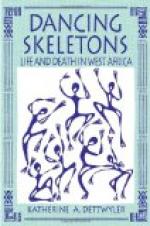|
This section contains 620 words (approx. 3 pages at 300 words per page) |

|
In West African cities and villages, buildings were arranged according to people's concepts of daily relations The Dogon, for example, designed their villages according to kinship patterns and religious beliefs, revealing the way in which their spirituality permeated their everyday life Anthony Atmore and Gillian Stacey have described how the Dogon situated and arranged their dwelling places
Twins occupied a crucial position in their thinking, being used to explain dualities as male and female, and accordingly villages were often twinned, one being on the plateau above the escarpment, the other among the rocks at the foot of the almost vertical cliff
An ideal village would extend from north to south like the body of a man lying on his back The head was the village council house, built on the chief square, which was the symbol of the primal field, cultivated...
|
This section contains 620 words (approx. 3 pages at 300 words per page) |

|




